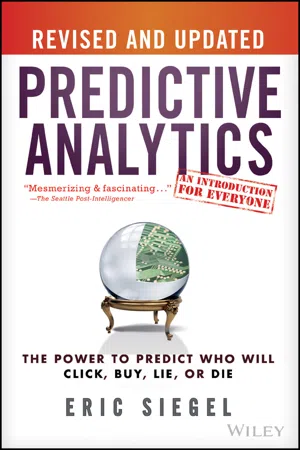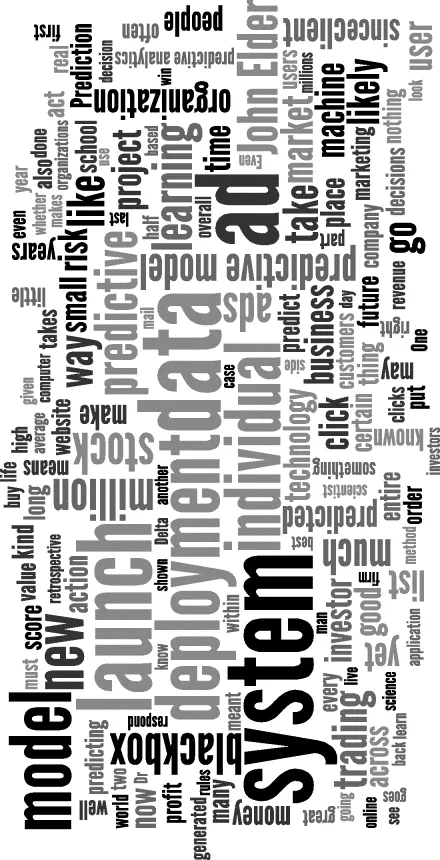
- English
- ePUB (mobile friendly)
- Available on iOS & Android
About this book
"Mesmerizing & fascinating..." — The Seattle Post-Intelligencer
"The Freakonomics of big data." —Stein Kretsinger, founding executive of Advertising.com
Award-winning | Used by over 30 universities | Translated into 9 languages
An introduction for everyone. In this rich, fascinating — surprisingly accessible — introduction, leading expert Eric Siegel reveals how predictive analytics (aka machine learning) works, and how it affects everyone every day. Rather than a "how to" for hands-on techies, the book serves lay readers and experts alike by covering new case studies and the latest state-of-the-art techniques.
Prediction is booming. It reinvents industries and runs the world. Companies, governments, law enforcement, hospitals, and universities are seizing upon the power. These institutions predict whether you're going to click, buy, lie, or die. Why? For good reason: predicting human behavior combats risk, boosts sales, fortifies healthcare, streamlines manufacturing, conquers spam, optimizes social networks, toughens crime fighting, and wins elections. How? Prediction is powered by the world's most potent, flourishing unnatural resource: data. Accumulated in large part as the by-product of routine tasks, data is the unsalted, flavorless residue deposited en masse as organizations churn away. Surprise! This heap of refuse is a gold mine. Big data embodies an extraordinary wealth of experience from which to learn. Predictive analytics (aka machine learning)unleashes the power of data. With this technology, the computer literally learns from data how to predict the future behavior of individuals. Perfect prediction is not possible, but putting odds on the future drives millions of decisions more effectively, determining whom to call, mail, investigate, incarcerate, set up on a date, or medicate. In this lucid, captivating introduction — now in its Revised and Updated edition — former Columbia University professor and Predictive Analytics World founder Eric Siegel reveals the power and perils of prediction:
- What type of mortgage risk Chase Bank predicted before the recession.
- Predicting which people will drop out of school, cancel a subscription, or get divorced before they even know it themselves.
- Why early retirement predicts a shorter life expectancy and vegetarians miss fewer flights.
- Five reasons why organizations predict death — including one health insurance company.
- How U.S. Bank and Obama for America calculated the way to most strongly persuade each individual.
- Why the NSA wants all your data: machine learning supercomputers to fight terrorism.
- How IBM's Watson computer used predictive modeling to answer questions and beat the human champs on TV's Jeopardy!
- How companies ascertain untold, private truths — how Target figures out you're pregnant and Hewlett-Packard deduces you're about to quit your job.
- How judges and parole boards rely on crime-predicting computers to decide how long convicts remain in prison.
- 182 examples from Airbnb, the BBC, Citibank, ConEd, Facebook, Ford, Google, the IRS, LinkedIn, Match.com, MTV, Netflix, PayPal, Pfizer, Spotify, Uber, UPS, Wikipedia, and more.
How does predictive analytics work? This jam-packed book satisfies by demystifying the intriguing science under the hood. For future hands-on practitioners pursuing a career in the field, it sets a strong foundation, delivers the prerequisite knowledge, and whets your appetite for more.
A truly omnipresent science, predictive analytics constantly affects our daily lives. Whether you are a consumer of it — or consumed by it — get a handle on the power of Predictive Analytics.
Frequently asked questions
- Essential is ideal for learners and professionals who enjoy exploring a wide range of subjects. Access the Essential Library with 800,000+ trusted titles and best-sellers across business, personal growth, and the humanities. Includes unlimited reading time and Standard Read Aloud voice.
- Complete: Perfect for advanced learners and researchers needing full, unrestricted access. Unlock 1.4M+ books across hundreds of subjects, including academic and specialized titles. The Complete Plan also includes advanced features like Premium Read Aloud and Research Assistant.
Please note we cannot support devices running on iOS 13 and Android 7 or earlier. Learn more about using the app.
Information

Chapter 1
Liftoff! Prediction Takes Action
How much guts does it take to deploy a predictive model into field operation, and what do you stand to gain? What happens when a man invests his entire life savings into his own predictive stock market trading system? Launching predictive analytics means to act on its predictions, applying what's been learned, what's been discovered within data. It's a leap many take—you can't win if you don't play.
Going Live
Learning from data is virtually universally useful. Master it and you'll be welcomed nearly everywhere!—John Elder
- wildly increasing loads of data;
- cultural shifts as organizations learn to appreciate, embrace, and integrate predictive technology;
- improved software solutions to deliver PA to organizations.
- What's predicted: the kind of behavior (i.e., action, event, or happening) to predict for each individual, stock, or other kind of element.
- What's done about it: the decisions driven by prediction; the action taken by the organization in response to or informed by each prediction.
- What's predicted: Which customers will respond to marketing contact.
- What's done about it: Contact customers more likely to respond.

A Faulty Oracle Everyone Loves
The first step toward predicting the future is admitting you can't.—Stephen Dubner, Freakonomics Radio, March 30, 2011
The “prediction paradox”: The more humility we have about our ability to make predictions, the more successful we can be in planning for the future.—Nate Silver, The Signal and the Noise: Why So ManyPredictions Fail—but Some Don't

Predictive Protection
Table of contents
- Cover
- Praise for Predictive Analytics
- Title Page
- Copyright
- Dedication
- Foreword Thomas H. Davenport
- Preface to the Revised and Updated Edition
- Preface to the Original Edition
- Introduction: The Prediction Effect
- Chapter 1: Liftoff! Prediction Takes Action
- Chapter 2: With Power Comes Responsibility: Hewlett-Packard, Target, the Cops, and the NSA Deduce Your Secrets
- Chapter 3: The Data Effect: A Glut at the End of the Rainbow
- Chapter 4: The Machine That Learns: A Look inside Chase's Prediction of Mortgage Risk
- Chapter 5: The Ensemble Effect: Netflix, Crowdsourcing, and Supercharging Prediction
- Chapter 6: Watson and the Jeopardy! Challenge
- Chapter 7: Persuasion by the Numbers: How Telenor, U.S. Bank, and the Obama Campaign Engineered Influence
- Afterword: Eleven Predictions for the First Hour of 2022
- Appendices
- Hands-On Guide: Resources for Further Learning
- Acknowledgments
- About the Author
- 182 Examples of Predictive Analytics: A Cross-Industry Compendium of Mini-Case Studies
- Index
- End User License Agreement